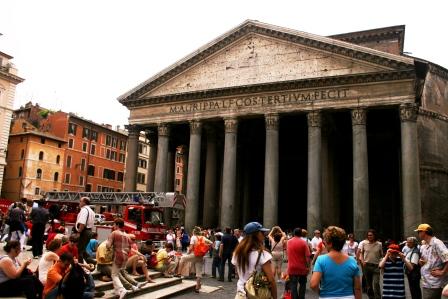
Posted on 05/13/2013 6:37:41 AM PDT by NYer
Today is the anniversary of the Dedication of the Roman church Santa Maria “ad Martyres“, which took place in 609. This church is also called the Pantheon.
Since on upcoming Pentecost, Roman firefighters will be dropping red rose petals through the oculus of the mighty building, I figured we could review what I have posted in the past.
In Rome on Pentecost, in the Pantheon, now a minor basilica called S. Maria ad martyres there is a beautiful custom.
Rose petals are dropped through the circular oculus opening at the top of the dome, which is the widest is all of Rome, for all its antiquity. The petals fall to the crowds below, reminiscent of the coming of the Holy Spirit like tongues of flame.
I posted photos taken over two different years here. Some show the event from the inside of the Pantheon, and some show the mechanics from the outside. My windon of my room in Rome was perfectly situated to see the dome of the Pantheon.
Here is how they get it done! Notice the fire truck parked in front of the Pantheon.

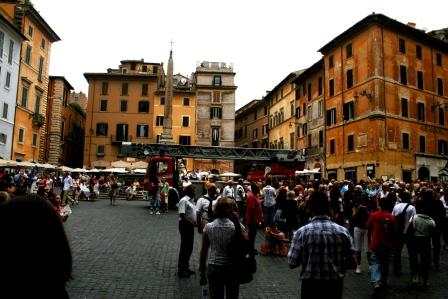
The firemen, waiting on top of the dome, for the signal to drop the flower petals…

The moment arrives!

From within…
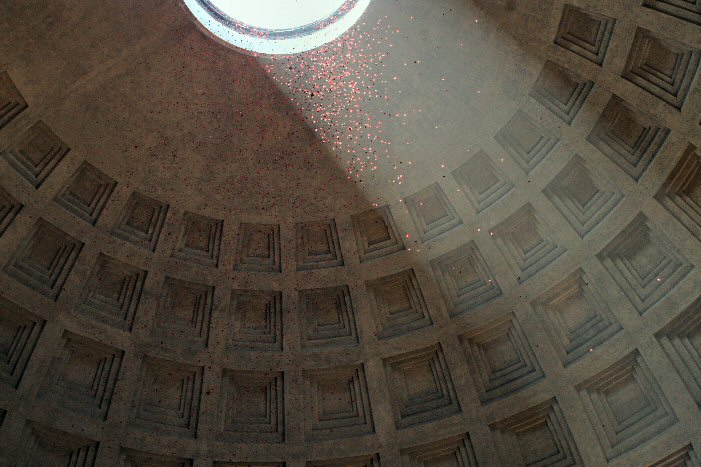
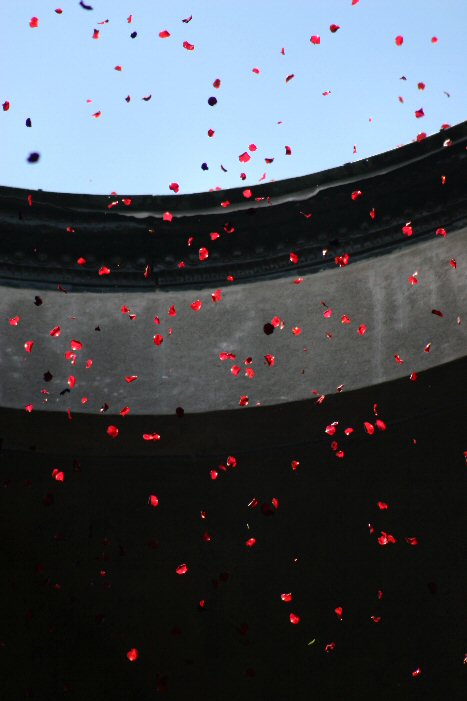
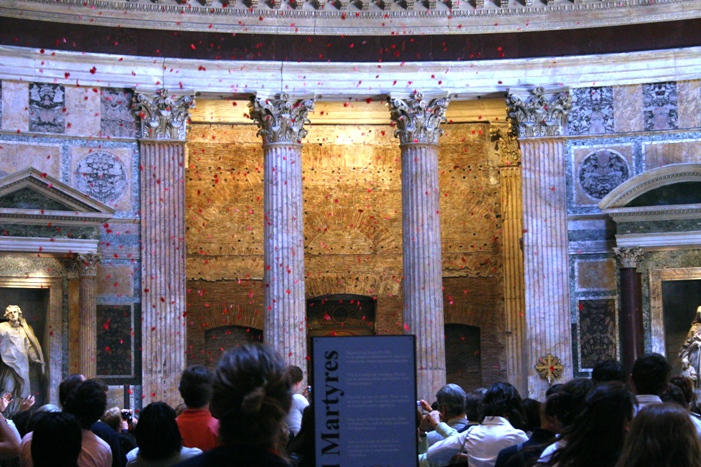
This is one of those lovely customs which we have only in Rome.
Rome Pentecostal Sunday at the Pantheon - Choral Conductor - You Tube Video
What a lovely custom. I wonder where they get all the rose petals? Do the parishioners contribute them? Do people grow gardens full of red roses just for this purpose?
Bellissima!
It's too cold in Rome at this time of the year, to grow roses. Just like we import fruits and flowers from various parts of the US and S. America, they do the same in Europe.

BTW, The history of Pantheon dates back to 27 B.C., when it was first conceived by Marcus Agrippa as a temple to the Gods (Pantheon meaning, of course, "all the gods"). Over 150 years later, emperor Hadrian oversaw its completion, and is credited with turning it into one of the most recognizable architectural works in the world. The cavernous space rises 142 feet into the air while its base measures the same - a perfect sphere astride a corresponding cylinder with an immense bronze ceiling. A hole at the dome's apex allows daylight into the majestic main room, a shifting spotlight that slowly fades into twilight and allows no defense against the rain or the occasional Roman snowfall. Pantheon history states that the interior of the roof is intended to symbolize the heavens, and the giant hole above is supposedly the eyes of the gods.
A precarious moment in the history of Pantheon was the fall of the Roman Empire. But unlike many institutions at the time, the Roman Pantheon managed to escape destruction as Barbarians flooded the city. Historians disagree as to why the conquerors elected to preserve this building while destroying so many others, and thus their motives may forever remain a mystery. Regardless, it was the pivotal moment in Pantheon history.
Beneath the light and between the granite Corinthian columns, seven sculptures stand. These Roman gods correspond to each of the seven planets (at the time) and remain in their original spots, despite the church being consecrated as a Christian church by Pope Boniface IV in 609. But the Roman Pantheon seems to exist independent of religious rule - more a tribute to the past than any specific spiritual figures. The history of Pantheon was forever changed during the reign of Pope Urban VIII, who melted down every scrap of bronze located upon the ceiling, outraging a great deal of Roman citizens. The great bronze doors escaped destruction, however, and remain today, a glowing testament to Pantheon history.
As the best preserved example of monumental Roman architecture, the Pantheon was enormously influential on European and American architects from the Renaissance to the 19th century. Michelangelo studied the dome before creating the cupola of St. Peter's. The concrete used to create the famous dome is one of the great examples of the progressiveness of Roman culture in the first millennium. In fact, the exact composition of the material is still not known, but appears to be structurally similar to modern day concrete.
You can take a 360 degree tour here.
Disclaimer: Opinions posted on Free Republic are those of the individual posters and do not necessarily represent the opinion of Free Republic or its management. All materials posted herein are protected by copyright law and the exemption for fair use of copyrighted works.